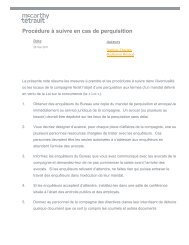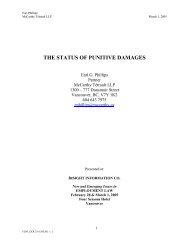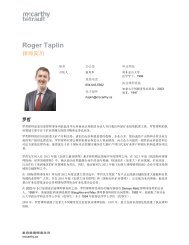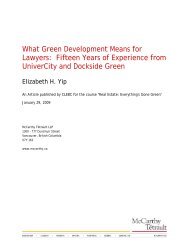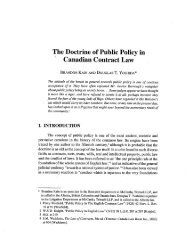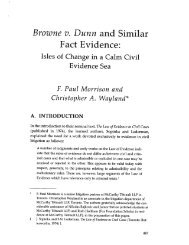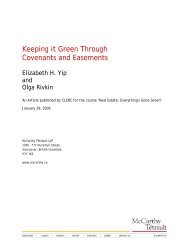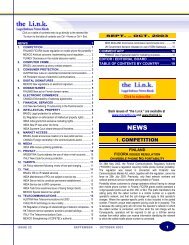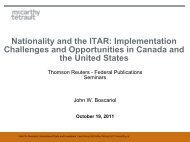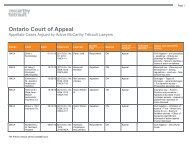Presentation Material - McCarthy Tétrault
Presentation Material - McCarthy Tétrault
Presentation Material - McCarthy Tétrault
You also want an ePaper? Increase the reach of your titles
YUMPU automatically turns print PDFs into web optimized ePapers that Google loves.
Chris Falk<br />
Stefanie Morand<br />
<strong>McCarthy</strong> Tétrault LLP<br />
In declining to comment on the possible application of subsection 84(2) in this example, the<br />
CRA noted that the provision requires that funds or property of a particular corporation must<br />
have been distributed or otherwise appropriated in any manner whatever to or for the benefit of<br />
the shareholders on the winding-up, discontinuance or reorganization of the business of the<br />
particular corporation (i.e., ACo) (in which case a deemed dividend would result to the extent<br />
that the redemption proceeds exceeded the PUC of the shares).<br />
The CRA noted that while it had ruled favourably in prior advance rulings on the non-application<br />
of subsection 84(2) (in addition to ruling favourably on section 84.1 and the general antiavoidance<br />
rule in subsection 245(2) (“GAAR”)), 24 the ruling applications in those cases provided<br />
that:<br />
• the corporation in question (e.g., the equivalent of ACo and XCo in the examples set out<br />
above) would remain a separate and distinct entity for at least one year (i.e., that it would<br />
not be wound up into or amalgamated with another corporation);<br />
• during this period, the corporation would continue to carry on its business in the same<br />
manner as before; and<br />
• only thereafter would the note be repaid (or would PUC of shares be reduced), on a<br />
progressive basis.<br />
The CRA indicated that, in these circumstances, it was reasonable to conclude that the<br />
conditions for the application of subsection 84(2) had not all been satisfied.<br />
While the CRA declined to comment on the application of subsection 84(2) in the example<br />
considered, the CRA noted, from the perspective of tax planners perhaps somewhat hopefully,<br />
that the three conditions summarized above that had been referred to in the favourable rulings<br />
were facts submitted by the taxpayers in question and could not be considered CRA<br />
requirements. 25<br />
While the CRA’s position remained uncertain following this Round Table discussion, the<br />
discussion placed tax planners on notice that the CRA might take the position that subsection<br />
84(2) could give rise to a deemed dividend in a pretty typical pipeline plan.<br />
Subsequently, in a withdrawn ruling request in respect of a proposed post-mortem pipeline plan<br />
involving a holdco that was inactive and owned only liquid assets (which assets were possibly<br />
only cash), the CRA took the position that the holdco’s surplus would be subject to dividend<br />
24<br />
25<br />
its $100,000 ACB. Provided that this capital loss was triggered in the estate’s first taxation year, subsection<br />
164(6) would generally permit the executor or executrix to elect to have the capital loss treated as a capital loss<br />
of the deceased in his or her terminal year rather than a capital loss of the estate. This capital loss could then be<br />
used to offset the capital gain arising in the deceased’s terminal year by reason of the deemed disposition on<br />
death.<br />
CRA Document Nos. 2002-0154223, dated November 13, 2002, and 2005-0142111R3, dated November 2,<br />
2005.<br />
The CRA had previously explained these rulings in a similar manner in a technical interpretation (CRA Document<br />
No. 2006-0170641E5, dated June 29, 2006).<br />
560600/422632<br />
MT DOCS 11864055v1G<br />
6



